Jacques Audiard Rust and Bone
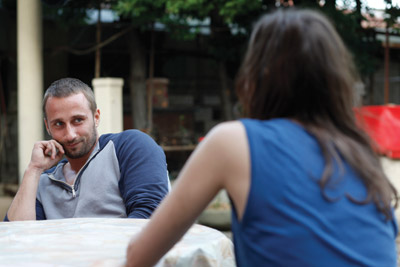
Rust and Bone
Cast: Marion Cotillard, Mathias Schoenaerts, Armand Verdure,Director: Jacques Audiard
Genre: Drama, Romance
Rated: MA
Running Time: 120 minutes
Synopsis: Ali (Matthias Schoenaerts) finds himself with a five-year-old child on his hands. Sam (Armand Verdure) is his son, but he hardly knows him. Homeless, penniless and friendless, Ali takes refuge with his sister Anna (Corinne Masiero) in Antibes, in the south of France. There things improve immediately. She puts them up in her garage, she takes the child under her wing and the weather is glorious.
Ali, a man of formidable size and strength, gets a job as a bouncer in a nightclub. He comes to the aid of Stephanie (Marion Cotillard) during a nightclub brawl. Aloof and beautiful, Stéphanie seems unattainable, but in his frank manner Ali leaves her his phone number anyway. Stephanie trains orca whales at Marineland. When a performance ends in tragedy, a call in the night again brings them together.
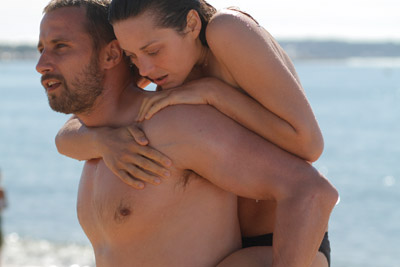 When Ali sees her next, Stephanie is confined to a wheel chair : she has lost her legs and quite a few illusions. Ali's direct, unpitying physicality becomes Stéphanie's lifeline, but Ali too is transformed by Stéphanie's tough resilience. And Stephanie comes alive again. As their stories intersect and diverge, they navigate a world where strength, beauty, youth and blood are commodities- but where trust, truth, loyalty and love cannot be bought and sold, and courage comes in many forms.
When Ali sees her next, Stephanie is confined to a wheel chair : she has lost her legs and quite a few illusions. Ali's direct, unpitying physicality becomes Stéphanie's lifeline, but Ali too is transformed by Stéphanie's tough resilience. And Stephanie comes alive again. As their stories intersect and diverge, they navigate a world where strength, beauty, youth and blood are commodities- but where trust, truth, loyalty and love cannot be bought and sold, and courage comes in many forms. Rust and Bone
Release Date: March 28, 2013
From the Filmmakers
In Craig Davidson's gripping short story collection Rust and Bone, individual lives and destinies are blown out of proportion, intensified by drama and accident. The stories depict a harsh modern world where fighting is the way the physical self finds its place and escapes its fate.Ali and Stéphanie, our two characters, do not appear in the short stories; we took ideas from Craig Davidson's stories as a point of departure and wove them into a new story. Davidson's collection already seems to belong to the prehistory of the project, but the power and brutality of our tale, our desire to use drama, indeed melodrama, to magnify our characters all have their immediate source in those stories.
From the very beginning of our adaptation, we were focused on a kind of cinematography that, for want of a better word, we called 'expressionist.' We wanted the power of stark, brutal, clashing images in order to further the melodrama. We had in mind an echo of the Great Depression. We thought of old amateur county-fair films, of the dark reality in those surreal visuals.
It is that kind of aesthetic that constantly guided us as we worked on the screenplay. It's pitiless, yet it sustains a love story that is the true hero of the film. It shows the world through the eyes of a confused child. It underscores the nobleness of our characters in a world made violent by economic disaster. And it respects Ali and Stéphanie's stubborn attempts to transcend their condition.
-Jacques Audiard and Thomas Bidegain
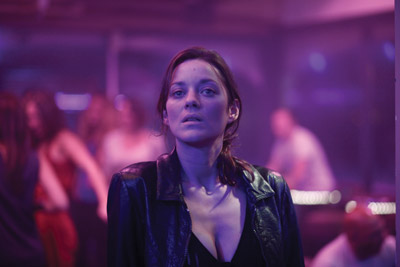
Production Notes
Just as the principal characters Stéphanie and Ali are transformed in Rust and Bone, so the film's director and lead actors went through a discovery process together that was not always easy or predictable."When I read the script, I loved Stéphanie right away, but I have to say that I didn't really understand her," recalls Marion Cotillard, who stars as the orca trainer who loses her legs. "I was a bit freaked out to confess that to Jacques Audiard, and he said, 'Well you know, it's the same for me. I don't know who she is and we're going to have to take the road together and find her and give her life.' That was very exciting for me. At the end, there's still some mystery about Stéphanie."
That sense of diving headlong into the unexpected touches every aspect of Rust and Bone. "What we were trying to do, with the writing, filming, actors' performances, editing, music," says director Jacques Audiard, "was to combine an almost naturalistic realism with its opposite-melodrama, surreal imagery, a heightened experience." So when Marion Cotillard worried about how to act out Stéphanie's trauma, Jacques Audiard saw her uncertainty as a plus: "Jacques Audiard said: 'That's the story of the movie: there's this girl and-bam!-she has no legs! It's entirely new to Stéphanie, and it's better if it's entirely fresh to you.' "
Re-imagining the love story
Rust and Bone began as a totally re-imagined departure from its source material. Jacques Audiard explains: "I'd read Craig Davidson's short story collection Rust and Bone with tremendous pleasure. Craig Davidson is a writer of the Crisis. He brutally depicts a modern world that is wobbling; his characters are on the margins, outside society. After A Prophet, a film about confinement, a world of men, without much light, (co-writer) Thomas Bidegain and I were drawn to follow up with a film that would be its opposite: a love story, bathed in light that would show a woman with a man. Yet we also wanted to explore contemporary chaos and arbarism without addressing them head-on. The contrasts fascinated us-but there isn't a love story in Craig Davidson's collection, so we invented it."
Before love in this story, though, comes pain. As Ali and Stéphanie bring each other back to life, they navigate a world of violence and scarred emotions. Jacques Audiard worked with his actors to portray the relationship with powerful resonance.
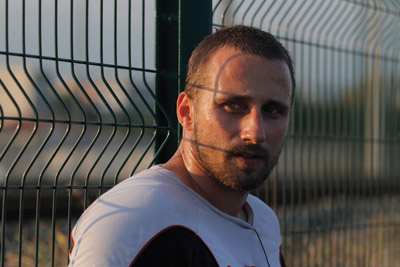 "Jacques Audiard is constantly looking for the life in the moment itself," says Matthias Schoenaerts (pronounced shuh-nar). "He's not about executing what he wrote, he's constantly on the lookout for "how can life change what I wrote?" Ali is not always the most sympathetic guy; the audience isn't going to identify with him straight away. But there's something about his sincerity, his simplicity, that's genuinely attractive. We rehearsed and improvised, trying out darker, rougher ways to play Ali. Finally, we struck on an almost childlike streak in Ali which made the character suddenly more real to us, more believable as someone Stéphanie could love. That juvenile energy breathed life into him. Otherwise he's this social, self-aware character that knows what shit he's in and starts being depressed about it, and we didn't want that at all. Ali goes from being an emotional zero to surrendering to love. He also learns to love his child. Jacques Audiard has a way of making characters so profound and so multilayered. He's truly an actor's director, who works with the actors very collaboratively to bring out those shades."
"Jacques Audiard is constantly looking for the life in the moment itself," says Matthias Schoenaerts (pronounced shuh-nar). "He's not about executing what he wrote, he's constantly on the lookout for "how can life change what I wrote?" Ali is not always the most sympathetic guy; the audience isn't going to identify with him straight away. But there's something about his sincerity, his simplicity, that's genuinely attractive. We rehearsed and improvised, trying out darker, rougher ways to play Ali. Finally, we struck on an almost childlike streak in Ali which made the character suddenly more real to us, more believable as someone Stéphanie could love. That juvenile energy breathed life into him. Otherwise he's this social, self-aware character that knows what shit he's in and starts being depressed about it, and we didn't want that at all. Ali goes from being an emotional zero to surrendering to love. He also learns to love his child. Jacques Audiard has a way of making characters so profound and so multilayered. He's truly an actor's director, who works with the actors very collaboratively to bring out those shades." Marion Cotillard concurs. "I've worked with amazing directors," she says, "But the thing with Jacques Audiard is you feel the love that he has for his story and the characters-it's so strong, it's very, very inspiring. Jacques Audiard is a poet."
Realism and its opposites
Jacques Audiard and cinematographer Stéphane Fontaine, who also shot A Prophet and The Beat That My Heart Skipped, evoke a harshly commercialised setting of urban strips, big-box retail, the anonymous disco, the touristy orca show-but they also make the audience feel the liberating sensation of sun and seawater on Stéphanie's body, the physicality and adrenaline of sex and combat. Gritty social realism slides into dreamlike imagery, as Jacques Audiard describes: "We were obsessed with the idea that the strength of the images would render this painting of passions, extreme situations, extreme feelings. We wanted to find a brutal and contrasting aesthetic.
We talked about neo-expressionism, Tod Browning's Freaks, the films of Lon Chaney, the circus and fairground films of the Great Depression, in which the strangeness of the visuals sublimates the blackness of reality. We talked about monstrous tales. And about Charles Laughton's Night of the Hunter, which begins with a father being arrested in front of his son because he has stolen in order to feed them. Are those films melodramas? Are they expressionistic? We don't have a lexicon for that." Like Fontaine, many key crew members-producers, editor, music composer, art director, casting, production designers- are longtime collaborators on Jacques Audiard's films.
Physical duress
As actors, both Marion Cotillard and Mathias Schoenaerts had to inhabit bodies under extreme physical duress. "I researched and I watched videos of amputees," says Marion Cotillard, "But I got more out of a direction Jacques Audiard gave me. He told me, "Sometimes part of her refuses the situation so sometimes she will try to stand up and she will forget that she has no legs and she will fall."
You don't see that onscreen but it made me feel the part." Technically, the amputations are achieved by CGI, but to Marion Cotillard, "That's the least interesting part, though the technical people did amazing work. What matters is the flesh, bones, sexual, violent physicality."
Mathias Schoenaerts trained intensively for his role as a kickboxing combatant, but not to achieve the conventional hero's ripped physique: "I worked out every day, had to get my weight back up after Bullhead. Jacques had a very specific idea of the physique that Ali should have-he should be strong but not trained. Here's a guy who has been boxing for years but then dropped out and started gaining weight, he has a belly. We didn't want him to look too fit or well trained; we wanted him to look a little bit unhealthy. He's a guy who doesn't have the means to be eating right and training properly and his appearance should make that clear."
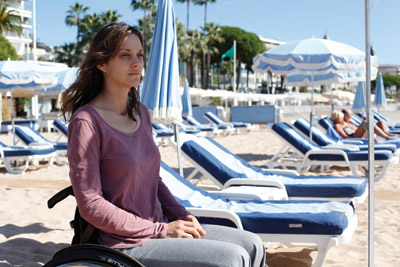 About his character's bare-fisted fighting, Mathias Schoenaerts says: "When you have nothing what is there left to sell? There's your body, so he fights. And somehow he needs the pain. The fights are painful but they're very sensory. He's unable to feel his emotional level, but the fights bring it to life, that's where he feels he has a body. When he hits or gets hit he feels it, there's something happening. And then Stephanie just breaks his heart open."
About his character's bare-fisted fighting, Mathias Schoenaerts says: "When you have nothing what is there left to sell? There's your body, so he fights. And somehow he needs the pain. The fights are painful but they're very sensory. He's unable to feel his emotional level, but the fights bring it to life, that's where he feels he has a body. When he hits or gets hit he feels it, there's something happening. And then Stephanie just breaks his heart open." In bed
The sexual chemistry between Ali and Stéphanie transcends her disability. Says Jacques Audiard, "Personally, I perceived the erotic nature of the situation quite quickly. Let me explain: there are two problems facing fiction films, two areas where they come up short: violence leading to death, because you know that they're not going to kill the actor; and sex, because you know that the sighs and pleasure are a sham - plus, it's very awkward to film. For a long time I've pondered the problem of the representation of physical love. This story allows me to avoid the problem of representation of the sexual act. When Ali takes Stéphanie on his back, it's all about sex. So when they're in bed, I no longer have to linger on the faces, to believe the faces; I believe what the woman is revealing of herself, her infirmity, and it's like she's even more naked."
As Mathias Schoenaerts says, "Of course I forgot her legs. Ali forgets, so I forgot."
The princess and the fighter
"I can't imagine who else could have played Stéphanie, just as I can't imagine who else could have played Piaf in La Vie en rose," says Jacques Audiard. "There's a virile authority to her acting, and at the same time she exudes sexuality. She's very seductive. There's another reason: I'm not forgetting that she's extremely famous. And that fame adds to the fiction. When her legs are amputated, it's a cinematic convention: we know it's a famous actress playing a role. She's a princess, a princess who falls from on high."
Jacques Audiard continues: "When I saw Bullhead, I immediately wanted to meet Matthias Schoenaerts. We had very little time to prep. Marion Cotillard focused her work on her handicap and the killer whales, and Mathias Schoenaerts on the fights. For her, the arc was difficult but clear: she is someone on the path to recovery. With Mathias Schoenaerts, we had to work more on his character: in the script, Ali was coarser. He couldn't be too dim, he had to attract Stéphanie's gaze, there had to be a basis for seduction and then love."
The seemingly positive wrap-up-Ali's boxing triumph, Sam and Stéphanie at his side-is mitigated by the voice-over which tells of the enduring pain in Ali's shattered hands. As Mathias Schoenaerts sees it, "We just watched a film for one and a half hours where we saw what these two human beings are and what they went through. They're still going to have to deal with that-it's not over. They still have pain, they still have to bring up the kid, she still has to deal with her handicap. But they can share it and be a support to one another, so it's a good ending but I wouldn't necessarily call it a classical happy ending."
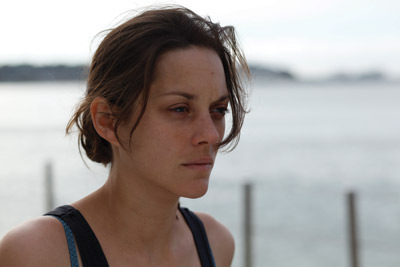 Jacques Audiard wonders, "What would she have become if she hadn't had that accident? She probably would have remained the somewhat arrogant princess that she was, unable to truly love someone. 'Thanks' to her infirmity, and because Ali never looks at her with pity or compassion, she allows herself to let go and experiences something she would otherwise never have known."
Jacques Audiard wonders, "What would she have become if she hadn't had that accident? She probably would have remained the somewhat arrogant princess that she was, unable to truly love someone. 'Thanks' to her infirmity, and because Ali never looks at her with pity or compassion, she allows herself to let go and experiences something she would otherwise never have known." For Marion Cotillard, her character's loss is a revelation. "When there's nothing left, it's just you, your soul, and what's deep inside of you. Will you be able to face it or will you be too afraid to face it? We see the encounter of two naked souls who surrender to this nudity. That's the beauty of this story and these people."
MORE
- Mission: Impossible Fallout
- Glenn Close The Wife
- Allison Chhorn Stanley's Mouth Interview
- Benicio Del Toro Sicario: Day of the Soldado
- Dame Judi Dench Tea With The Dames
- Sandra Bullock Ocean's 8
- Chris Pratt Jurassic World: Fallen Kingdom
- Claudia Sangiorgi Dalimore and Michelle Grace...
- Rachel McAdams Disobedience Interview
- Sebastián Lelio and Alessandro Nivola...
- Perri Cummings Trench Interview



